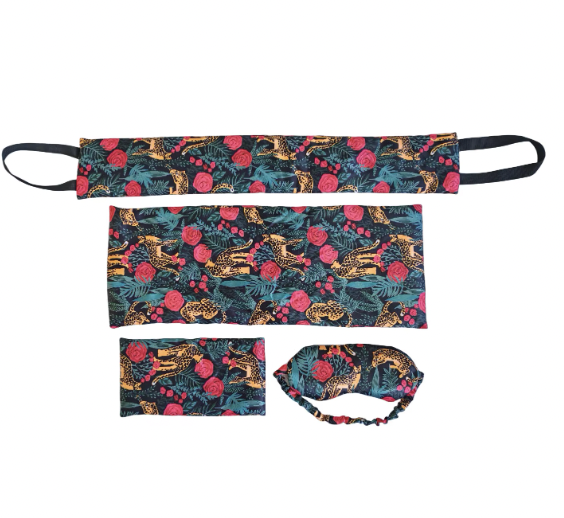The Science Behind Microwave Moist Heat Therapy
How Moist Heat Penetrates Muscle Tissue
Moist heat therapy works wonders because it uses water vapor to get deeper into muscles than regular heat does, helping people feel better when they're sore or tense. Some research shows moist heat goes about 3 cm into muscle tissue, much deeper than what dry heat can manage. Getting heat so deep matters a lot for real muscle relief. When someone uses those microwaveable packs, the steam they produce actually warms up the area pretty well. This warming effect helps cells work better and speeds up healing too. A study from the Journal of Physical Therapy Science backs this up, finding that getting heat deep into muscles makes them less stiff and more flexible overall. For anyone dealing with muscle pain, these benefits make moist heat worth considering over other options.
Blood Flow Enhancement and Pain Relief Mechanisms
Moist heat therapy really helps because it makes blood vessels expand, which gets blood flowing better throughout the body. Better circulation means oxygen and nutrients reach damaged areas faster. The extra blood flow also helps flush out waste products from muscles and joints, so people tend to heal quicker and feel less pain overall. Research backs this up too showing folks recover faster after injuries when they get proper blood flow. Doctors often suggest moist heat treatments for things like stiff joints, tight muscles, and ongoing pain problems since it actually improves blood vessel function. When blood moves through tissues more efficiently, healing happens sooner and discomfort goes down, which is why many clinics use moist heat as part of their standard treatment plans for all sorts of physical issues.
Comparing Thermal Conductivity: Moist vs. Dry Heat
Looking at moist versus dry heat treatments reveals some pretty important differences, especially when it comes to how well they actually conduct heat. Moist heat has better thermal conductivity, so it gets warmth into sore spots much faster. Dry heat tends to dry out the skin and leave people feeling uncomfortable after a while. Moist heat works differently though - it keeps the skin moisturized during treatment, making the whole experience more pleasant. Research published in the International Journal of Sports Physical Therapy shows that moist heat raises muscle temperatures quicker than those standard dry heat pads most people have around. That's probably why so many athletes reach for moist heat packs before hitting the gym or playing sports. They work better and feel nicer on the body too. With this combination of fast heating action and overall comfort level, moist heat remains the go to choice for warming up muscles and joints prior to any kind of physical exertion.
How Microwave Moist Heat Packs Enable Real-Time Relief
Microwave Activation Process Explained
Moist heat packs heated in the microwave work by using those invisible waves we all know so well to get water molecules moving around, creating steam that delivers soothing warmth. Most people find that their packs are ready within just a minute or two, giving them fast relief when they need it most. One big plus of using the microwave method is getting that steady, even heat without those annoying hot spots that sometimes happen when someone tries to warm these packs in the oven instead. If folks take a moment to learn how different materials absorb microwave energy, they'll probably notice better results when activating their packs. That's why many people end up reaching for microwave heated options again and again whenever they want quick comfort after a long day on their feet or dealing with stiff muscles.
Sustained Heat Retention for Continuous Comfort
Microwave moist heat packs stay warm much longer than regular dry heating pads, giving people more comfort and better therapeutic results overall. The stuff inside matters too – flaxseeds work great because they soak up moisture so well, while rice grains also do the job pretty decently. When someone applies heat consistently over time, studies indicate this helps manage chronic pain conditions better since body tissues respond better to steady temperatures rather than sporadic bursts. Most folks find these packs last around 30 minutes give or take, sometimes even longer depending on how they're microwaved. That makes them really handy for sitting through meetings at work, watching TV in bed, or just needing continuous warmth without constantly replacing a pad. Compared to standard electric heaters or those disposable chemical packs, the moist variety tends to feel cozier and lasts noticeably longer between sessions.
Ideal Temperature Range for Therapeutic Effects
Moist heat therapy works best when the temperature stays within a range of around 104 to 113 degrees Fahrenheit (that's about 40 to 45 Celsius). This sweet spot helps relieve pain without causing burns. Keeping the heat in this window means the packs can do their job properly while keeping users safe from harm. People should check the temperature regularly to make sure it stays effective and doesn't become dangerous over time. Most experts suggest beginning with cooler settings first and then slowly turning up the heat until finding what feels just right. Everyone has different tolerance levels, so adjusting according to personal comfort makes sense for getting the full benefit out of these heat packs.
These packs exemplify effective microwave moist heat therapy, making them an indispensable tool in managing pain and promoting muscle relaxation.
Key Advantages Over Ice Packs and Dry Heat Methods
Superior Inflammation Reduction vs. Cold Therapy
When it comes to tackling inflammation, moist heat therapy really shines compared to regular ice packs. Ice packs work mainly by numbing the pain temporarily, but they don't address what's going on beneath the surface. Moist heat actually helps boost blood flow and gets more oxygen to the affected tissues, which cuts down on inflammation over time. What makes this approach so effective is that it opens up blood vessels (a process called vasodilation), letting healing happen faster. Cold therapy does the opposite by making blood vessels narrow. Doctors tend to recommend moist heat for long term issues with inflammation, whereas ice packs usually come into play when someone has just suffered an injury and needs to control sudden swelling right away.
Deeper Tissue Penetration Compared to Dry Heating Pads
When it comes to heating therapies, moist heat actually works better than those regular dry pads because it gets much deeper into muscles. According to research published in the Journal of Physiology, when there's moisture involved, the heat travels further down where it matters most, tackling those stubborn muscle knots and pains that standard pads just can't reach. People who suffer from things like fibromyalgia or arthritis tend to notice quicker improvements with this method since the warmth penetrates so deeply. Most athletic trainers will tell anyone who'll listen that they always reach for moist heat packs first when dealing with serious muscle injuries. The difference is night and day compared to old fashioned dry heating methods which just sit on top of the skin without really doing much good underneath.

Flexibility for Joints: Wrap-Around Designs
Microwave moisture packs with wrap around designs give much better flexibility and extra comfort, which makes them great for treating joints. People can put the heat right where it needs to go on their knees or elbows without worrying about it slipping off, so the actual healing effect is stronger too. Most folks who have tried these kinds of packs say they really like them because they don't stop movement while getting treated something important when someone has arthritis problems or similar issues with their joints. What makes these packs stand out is how well they target exactly where the pain is, plus they're easy to get on and take off whenever needed, giving longer lasting relief for those wanting to keep their joints moving properly.
By seamlessly integrating advanced features and flexible designs, microwave moisture packs provide a sophisticated alternative to traditional dry pads and ice packs, catering to diverse therapeutic needs.
Targeted Applications for Effective Pain Management
Knee and Joint Support: Wrap-Around Ice Pack Alternatives
Moist heat packs heated in the microwave work wonders for knee and joint pain, beating out regular ice packs most of the time. Ice just numbs things temporarily, while moist heat actually cuts down on how bad the pain feels and gets at some of the root problems whether someone has a fresh injury or something that's been going on for years. These packs come wrapped around so they stick better to sore spots and stay put, making them much more effective than loose heating pads. People who try them during recovery from knee injuries notice they can move around better and don't hurt as much afterward. Research backs this up too many folks find real improvement when they incorporate these into their daily routine for joint care.
Facial Use: Complementing Cooling Eye Masks for Puffiness
Adding moist heat packs to cooling eye masks really enhances their ability to fight off facial puffiness and those annoying sinus problems we all get sometimes. The warmth helps increase blood flow, and this in turn gets the lymphatic system working better, something that makes a big difference when trying to reduce swelling around the eyes. Studies have shown moist heat works wonders for tension headaches too, so combining it with cold treatments just makes sense. Luxury skincare companies are starting to catch on, launching their own versions of heated eye masks. Hot and cold therapy together seems to be catching fire in the beauty world these days, giving people a more complete way to deal with all sorts of facial puffiness issues without relying on just one method alone.
Neck/Shoulder Tension and Lower Back Pain Solutions
Moist heat therapy from microwave packs works wonders for those tight spots in the neck and shoulders, really helping people feel better and move around more easily. According to the Journal of Occupational Rehabilitation, these packs have actually made a real difference for folks suffering from long term lower back issues. When someone applies warm moist heat regularly, it tends to loosen up all that built up tension in muscles and helps wash away some of the daily stress too. Most people find they recover quicker after working out when they use this method. No surprise then that physical therapists often grab a pack of moist heat for their clients struggling with ongoing pain problems. Many clinics stock them because they just work so well at easing neck discomfort and reducing that nagging muscle tightness everyone gets from sitting at desks all day.
Frequently Asked Questions
What makes moist heat therapy more effective than dry heat?
Moist heat penetrates deeper into muscle tissue, promoting better pain relief and flexibility compared to dry heat.
How does moist heat therapy enhance blood flow?
It dilates blood vessels, improving circulation, oxygen delivery, and waste removal, which helps in quicker recovery.
Can I use microwave moist heat packs for any type of pain?
Yes, they are effective for muscle soreness, joint pain, and chronic conditions, but should be used with caution following safety guidelines.
What's the difference between homemade and commercial-grade microwave packs?
Homemade packs are cost-effective but may lack consistent heat retention, while commercial-grade packs offer durability and enhanced safety features.

